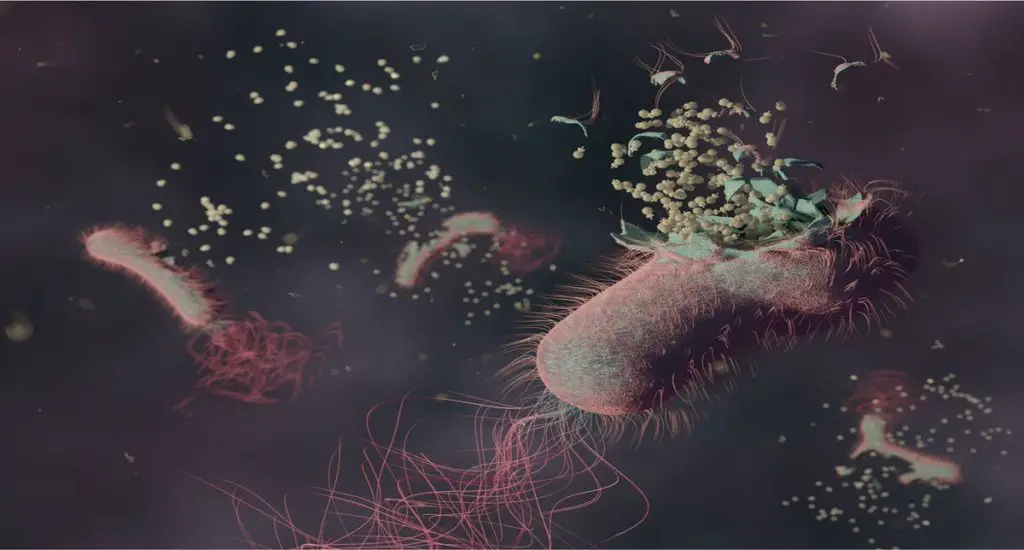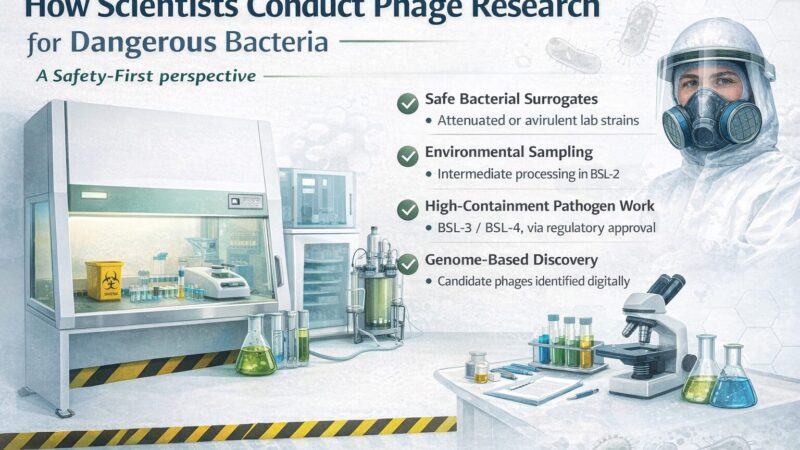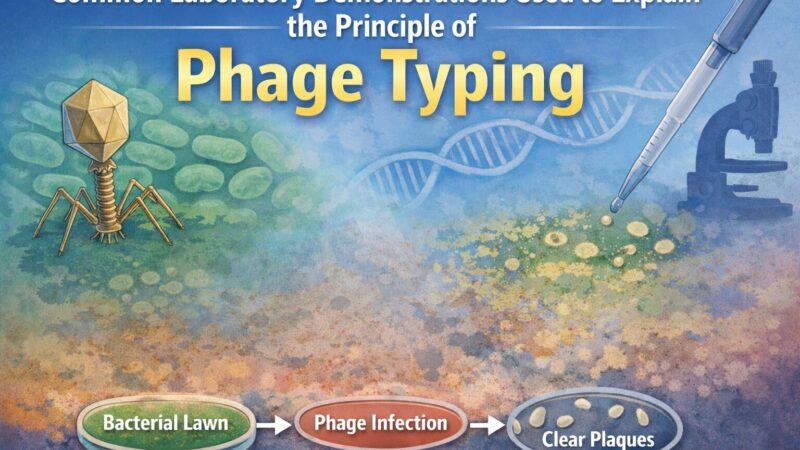
Bacteriophages, often called phages, are viruses that specifically target and infect bacteria. One of the most fascinating processes they can initiate is bacterial cell lysis (though not all phages cause lysis). In this process, the bacterial cell wall and membrane are destroyed, leading to the death of the bacterial cell. Phages exploit bacterial cells to replicate and, eventually, cause the destruction of the bacterial host through lysis. But how exactly does this process unfold, and why is it important for both biological research and practical applications like phage therapy?
In this blog, we will take an in-depth look at bacterial cell lysis during phage infection. We will explore how phages infect bacterial cells, how they hijack the bacterial machinery, and the molecular mechanisms that lead to lysis.
Understanding Bacteriophages
Before diving into the lysis process, let’s first understand the basics of bacteriophages.
Bacteriophages are viruses that specifically target bacteria. Most phages have a simple structure consisting of:
- Capsid: The protein coat that protects the viral genetic material (either DNA or RNA).
- Tail: A structure that helps the phage attach to and penetrate bacterial cells.
Phages are incredibly diverse, with various types showing different methods of infection and replication. However, the general lifecycle of a lytic bacteriophage follows these steps:
- Attachment (Adsorption): The phage attaches to specific receptors on the surface of the bacterial cell.
- Injection (Penetration): The phage injects its genetic material into the bacterial cell.
- Hijacking: The phage DNA or RNA takes control of the bacterial cell machinery to replicate itself.
- Assembly: New phage particles are assembled inside the bacterium.
- Lysis: The bacterial cell is destroyed, and the newly formed phages are released.
The final step, lysis, is a critical moment in the lifecycle of lytic bacteriophages. This is the phase where the bacterial cell is ruptured, and it’s what we will focus on in this post.
The Mechanism of Phage-Induced Bacterial Cell Lysis

When a bacteriophage infects a bacterium, its main goal is to replicate and produce new virions (virus particles). To do this, the phage must overcome the structural integrity of the bacterial cell wall—a tough, protective barrier made of peptidoglycan (a mesh-like polymer of sugars and amino acids). Cell lysis occurs through two key mechanisms:
- Phage-encoded lytic enzymes: These enzymes, often called endolysins, degrade the peptidoglycan layer.
- Holin proteins: These are phage-produced proteins that create pores in the bacterial membrane, aiding the release of endolysins.
Step-by-Step Breakdown of the Lysis Process
- Phage Infection and DNA Injection: After a phage binds to the bacterial surface, it injects its genetic material into the bacterial cytoplasm. This process is highly specific, and only phages that recognize the bacterium’s unique surface receptors can initiate the infection.
- Hijacking the Host’s Machinery: Once inside, the phage genetic material takes control of the bacterial cell, diverting its resources to produce phage components. Phage DNA is transcribed and translated into proteins, including the structural proteins needed to form new phage particles (capsid, tail fibers, etc.), and enzymes required for lysis, such as endolysins and holins.
- Replication of Phage Components: Phages replicate rapidly within the host cell. Thousands of new phage particles are synthesized, assembled, and packaged with viral DNA. However, the phage cannot exit the bacterial cell until the tough cell wall is broken down.
- The Role of Holin: Holins are small phage proteins that accumulate in the bacterial inner membrane. Once enough holin molecules have been produced, they form small holes or pores in the bacterial membrane. These holes serve two functions:
- Allow the endolysin proteins to pass through the membrane and reach the cell wall.
- Disrupt the cell membrane potential, which compromises the bacterial cell’s ability to maintain its internal environment.
- Endolysin Attack on the Cell Wall: Once holins have created pores in the membrane, endolysins—the lytic enzymes—are released from the cytoplasm into the periplasmic space (the space between the bacterial inner membrane and the outer cell wall). Endolysins have specialized activity: they degrade the peptidoglycan layer of the bacterial cell wall by breaking down its sugar backbone or cutting the peptide crosslinks. Without the structural integrity provided by the peptidoglycan, the bacterial cell wall can no longer withstand the internal pressure of the bacterial cytoplasm. The bacterial cell eventually bursts, a process known as osmotic lysis.
- Cell Bursting (Lysis): As the peptidoglycan layer is degraded, the bacterial cell becomes increasingly unstable. The internal pressure causes the cell to swell, and eventually, it ruptures, spilling its contents (including newly formed phages) into the surrounding environment. The cycle is complete, and the new phages are free to infect neighbouring bacterial cells.

Holin-Endolysin System: A Coordinated Attack
The holin-endolysin system is one of the most well-studied mechanisms of bacterial lysis. Holins and endolysins work together in a highly coordinated manner to ensure that lysis only occurs at the right time—after the new phage particles have been fully assembled.
- Timing of Holin Activity: Holins are regulated to form pores in the membrane only when the new phages are ready for release. If holins create pores too early, endolysins would degrade the cell wall prematurely, killing the bacterial cell before the phages are assembled. This precise regulation of timing is a hallmark of the phage lifecycle.
- Types of Endolysins: Endolysins are diverse in their action, with some targeting the glycan backbone of peptidoglycan, while others cut specific peptide bonds in the crosslinking chains. This variability allows phages to effectively lyse a wide range of bacterial species, each with slightly different peptidoglycan structures.
The Ecological and Practical Importance of Phage-Induced Lysis
The ability of phages to lyse bacterial cells has profound implications in nature and human applications.
1. Phage Therapy:
Phage therapy is a burgeoning field where bacteriophages are used to treat bacterial infections, especially in cases where antibiotic resistance poses a challenge. In phage therapy, lysis is the key event that kills the pathogenic bacteria, offering a targeted and efficient alternative to traditional antibiotics.
2. Bacterial Population Control:
In natural environments, phages play a critical role in controlling bacterial populations. By infecting and lysing bacterial cells, phages regulate microbial communities in oceans, soil, and even the human gut microbiome.
3. Research Tools:
Phages and their lytic enzymes are powerful tools in molecular biology and genetic research. For instance, endolysins are being explored for use as antimicrobial agents due to their ability to degrade bacterial cell walls without relying on the cell’s metabolic machinery (unlike antibiotics).
Let’s wrap it up
Phage-induced bacterial cell lysis is a complex but elegant process that underscores the incredible efficiency of viruses in controlling bacterial populations. The highly coordinated actions of holins and endolysins allow phages to destroy their bacterial hosts with precision, ensuring the survival and spread of the phages.
Understanding this process not only provides insight into fundamental biological mechanisms but also opens doors to innovative solutions for treating bacterial infections. Phage therapy, for example, is a promising alternative to antibiotics, and continued research into the mechanisms of bacterial lysis could revolutionize our approach to combating antibiotic-resistant bacteria.
Bacteriophages are thus not only crucial players in microbial ecology but also hold great potential in the ongoing battle against infectious diseases. Through the mechanism of cell lysis, they demonstrate a powerful, natural method for bacterial control—one that we are only just beginning to harness.
Cover photo credit@CEA-Leti
In-article photos created on bio-render



Leave a Reply
You must be logged in to post a comment.